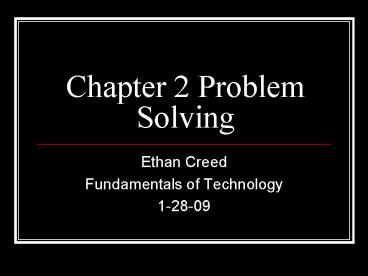Chapter 2 Problem Solving - PowerPoint PPT Presentation
Title:
Chapter 2 Problem Solving
Description:
Chapter 2 Problem Solving Ethan Creed Fundamentals of Technology 1-28-09 6-Step Problem Solving Process State the problem clearly Collect Information Develop possible ... – PowerPoint PPT presentation
Number of Views:43
Avg rating:3.0/5.0
Title: Chapter 2 Problem Solving
1
Chapter 2 Problem Solving
- Ethan Creed
- Fundamentals of Technology
- 1-28-09
2
6-Step Problem Solving Process
- State the problem clearly
- Collect Information
- Develop possible solutions
- Select the best solution
- Implement the solution
- Evaluate the solution
3
1) State The Problem Clearly
- Solving any problem starts with knowing what that
problem is. - While stating the problem actually suggests a
solution. - For example what about the problem of too much
garbage? 1) is the problem to design ways of
removing the garbage, or 2) to design ways of
reusing the garbage, or 3) to design ways of
making products to create less garbage? - A fourth possibility might be a combination of
all three.
4
2) Collect Information
- Once the problem is thoroughly understood,
information that can be used to develop a good
solution must be gathered. - Sources of information depend on the nature of
the problem.
5
3) Develop Possible Solutions
- Most problems have more than one solution. The
more possibilities people can come up with, the
better. - One way of developing alternative solutions is
through trial and error. - Example Thomas Edison was developing a practical
light bulb, he tried many types of materials for
the light bulb filament, including strands of red
hair. He failed many times. Finally, he found
that carbonized thread worked.
6
4) Select The Best Solution
- In order to choose the best one, all the possible
solutions must be evaluated. - Many factors must be considered, and a good
decision must be based on your goals and your
particular situation. - Part of a good problem solving is being able to
recognize which factors are most important. - There is rarely a perfect solution to a problem.
- Sometimes more than one solution to a problem
will be chosen because there is seldom one best
solution that fits all circumstances.
7
5) Implement The Solution
- During the implementation process, models are
made and ideas are tested to make sure the
solution is workable. - For example testing seat belt and air bag
designs for cars, auto manufacturers actually
stimulate crashes, using dummies in the cars.
8
6) Evaluate The Solution
- The information that was obtained from testing
helps refine the solution. - After the bugs have been worked out, the
technology can be put to use, but it doesnt end
here. - Sometimes the product could not be successful
with the consumers. They could have problems
assembling it in the first place.
9
Thinking Skills
- Critical-thinking skills
- Creative-thinking skills
- Decision-making skills
10
Critical-thinking skills
- This skill is used to analyze problems and make
judgments
11
Creative-thinking skills
- This skill is used to develop new, original ideas
or improve existing ideas.
12
Decision-making skills
- This skill is applied when making a choice among
several possibilities.
13
Scientific Method
- Make an observation
- Collect information
- Form a hypothesis
- Perform an experiment
- Analyze the results
- Repeat the process
14
Make an observation
- You might notice that certain green plants in
your yard grow better in sunlight than in shade
15
Collect information
- Does a particular green plant grow well only in
direct sunlight? What kinds of plants grow in
shade? How much sunlight do plants need to
thrive?
16
Form a hypothesis
- A hypothesis is an explanation that can be
tested. Your hypothesis might be Green Plant A
needs direct sunlight to grow well.
17
Perform an experiment
- Performing an experiment is used to see if your
hypothesis is correct or incorrect.
18
Analyze the Results
- How did your experiment turn out? Did the
experiment prove or disprove your hypothesis?
Collect data of the experiment in this stage.
19
Repeat the Process
- Example use other samples of the same plant











![Chapter 3: Simplex methods [Big M method and special cases] PowerPoint PPT Presentation](https://s3.amazonaws.com/images.powershow.com/4471558.th0.jpg?_=202101090310)



















